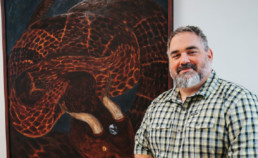Swain County October 2022
Population
14,136
County Seat
Bryson City
Median Income
$45,554
Population Density Designation
Rural
Kayaks were planted upright in the ground as we drove up to the Swain County home for Southwestern Community College (SCC). The kayaks are eye-catching, but they also represent the importance of outdoor recreation to the economy of Swain County. Federal land represents more than 75 percent of the total land in Swain County.1 The dominant chunk of the federal land belongs to the Great Smoky Mountains and the Nantahala National Forest according to Swain County manager Kevin King, with an additional significant percentage of the county falling within the Qualla Boundary territory of the Eastern Band of Cherokee Indians.
Swain County is known among travelers for whitewater rafting, tubing and kayaking. The Nantahala River is among the most popular rivers for whitewater rafting in the country.2 More than 200,000 people take to the river every year according to King. This emphasis on outdoor recreation has spawned significant industry in the county including the Nantahala Outdoor Center, which is why we spent some of our time in Swain County at SCC’s Swain Center learning more about the school’s Outdoor Leadership program. The program was created in the early 2000s, and it was the first program of its type in North Carolina.3
Paul Wolf leads the Outdoor Leadership program. Wolf emphasizes skill development through “hands-on” learning including a focus on food preparation, program planning and wilderness safety. Wolf showed us how students assemble camping packs with the right amount of protein and carbohydrates. We were able to smell — and taste — the dried food they had produced to support overnight camping. The course is so hands-on that Wolf joined us fresh from the Nantahala River where he had taken students down the river for needed certifications.
We were also able to visit SCC’s ceramics program during our time in Swain County. We spent time visiting several area artists who were working on their own pottery. The ceramics course is part of an overall Heritage Arts program that offers other courses in printmaking, painting, weaving and more.
Over lunch, we had a conversation about the opportunities and challenges facing the county — including a lack of broadband, limited cell service at times and a lack of affordable and accessible housing. Wolf noted residents often lose cell service, even in the areas where they typically have it, during the “summer crush” of tourists coming to hike the mountains and paddle the river.
One obstacle for the county to respond to these challenges is the lack of funding coming from property tax. Since more than three-fourths of the county’s land falls under federal control — or is held in trust for the Eastern Band of Cherokee Indians — the county generates a smaller amount of property taxes than most counties of their size, per King.
The benefits of the rivers, forests and mountains provide a unique opportunity for hundreds of thousands of people to explore Swain County each year. The question is how to grow the amenities and resources in the county given both the opportunity and the obstacles.
Qualla Boundary
We had the opportunity to visit the Qualla Boundary for a series of conversations around health and wellness, educational outcomes and workforce development for the tribal members of the Eastern Band of Cherokee Indians who call it home.
The Qualla Boundary land is held in trust by the federal government. The Eastern Band is a sovereign nation within the borders of the United States.4
We began our time in the Qualla Boundary with a visit to the Cherokee Indian Hospital Authority. Casey Cooper, the CEO of the Hospital Authority, guided us through a conversation around the mission and vision of the organization. The mission of the Hospital Authority is to “provide accessible, patient and family-centered quality health care with responsible management of the Tribe’s resources.”5 The vision is to be “significant in the lives of Tribal members, chosen for excellence and exceeding customer expectations, recognized for improving the health of the Eastern Band of Cherokee Indians.”5
The hospital provides more than 18,000 yearly primary care visits — and they have also hosted more than 22,000 annual emergency room visits.6 They also have an on-site pharmacy that fills tens of thousands of prescriptions annually.
Cooper guided us on a walking tour of the hospital. Every element of the hospital was designed to be calming, unique and rooted in the culture of the Eastern Band of Cherokee Indians. Cooper pointed out numerous artistic elements that were also included in the design of the hospital.
We traveled from the Hospital Authority to Cherokee Central Schools next. Yona Wade, the Director of Community Affairs for the schools, led our visit. The elementary, middle and high schools all sit on the same campus — alongside other key offices. The campus comprises 473,000 square feet of space,7 and it is the largest “green” project in the region according to Wade.
Wade also arranged for our group to visit the Cherokee Indian Fair to watch a stickball game. Stickball is considered to be one of the original sports played in North America — and it has a rich history among the Eastern Band of Cherokee Indians and other tribes.8

Meet Dr. Algie Gatewood
Dr. Algie Gatewood is only the fourth President to lead Alamance Community College (ACC) since it opened in 1958. During Dr. Gatewood’s tenure at ACC, the college won its largest ever bond referendum – nearly $40 million – in 2018 to fund a number of major capital projects and expansions. The college also secured $16 million in county funding in 2014 to build the Advanced Applied Technology Center. Other notable accomplishments include creating a Biotechnology Center of Excellence, introducing an Early College, facilitating an apprenticeship program, and introducing nearly two dozen new academic programs and articulation agreements with state universities.
1. Source: www.citizen-times.com/story/news/local/2017/04/19/nc-leaves-swain-schools-unequal-financial-footing/100026664
2. Source: www.greatsmokies.com/rafting
3. Source: www.ednc.org/students-find-their-niche-at-southwestern-community-college
4. Source: visitcherokeenc.com/eastern-band-of-the-cherokee
5. Source: cherokeehospital.org/about/mission-vision-values
6. Source: cherokeehospital.org/locations
7. Source: www.ccs-nc.org/apps/pages/index.jsp?uREC_ID=368975&type=d&pREC_ID=827793
8. Source: visitcherokeenc.com/blog/entry/how-the-eastern-band-of-cherokee-indians-plays-stickball
All other trade names are the property of their respective owners.
U39702, 1/23






